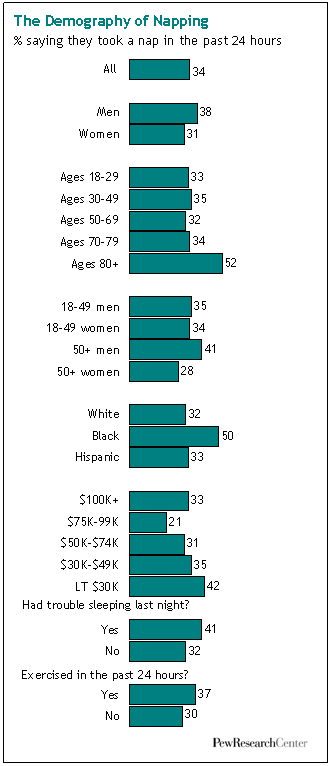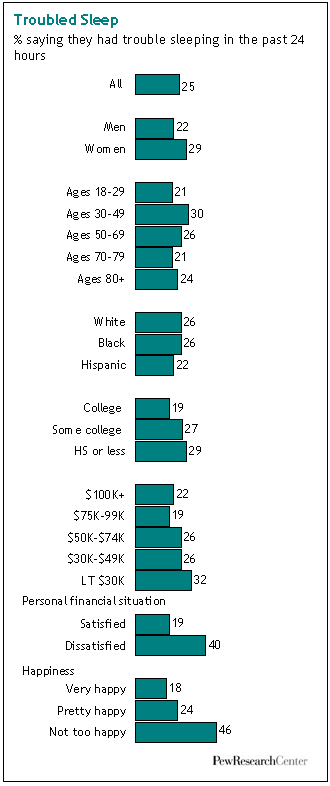
Feeling drowsy? You’re not alone. On a typical day, a third of the adults (34%) in the United States take a nap.
Napping thrives among all demographic groups, but it’s more widespread among some than others, according to a Pew Research Center Social & Demographic Trends survey of a nationally representative sample of 1,488 adults.
More men than women report that they caught a little snooze in the past 24 hours — 38% vs. 31%.This gender gap occurs almost entirely among older adults. More than four-in-ten ( 41%) men ages 50 and older say they napped in the past day, compared with just 28% of women of the same age. Below the age of 50, men and women are about equally likely to say they napped in the past day (35% vs. 34%).
There are distinctive racial patterns to napping. Half of the black adults in our survey say they napped in the past 24 hours, compared with just a third of whites and Hispanics.
Napping is quite common at the lower end of the income scale; some 42% of adults with an annual income below $30,000 report they napped in the past day. As income rises, napping declines. However, at the upper end of the scale (adults whose annual income is $100,000 or above) the tendency to nap revives and reverts to the mean.
Napping spikes among the old — but only among the very old.More than half of adults ages 80 and older say they napped in the past day. Among every other age group in the survey — including both the young (ages 18 to 29) and the old (ages 70 to 79) — about a third say they napped in the past 24 hours.
These findings are based on responses to a question in a wide-ranging survey about aging thatasked people if they had engaged in each of 10 different activities in the past 24 hours — among them driving a car, getting some exercise, going shopping, watching television, using the internet, praying and taking a nap.1

Trouble Sleeping?
The survey also asked respondents if they had trouble sleeping in the past 24 hours — and, not surprisingly, it finds a correlation between nap-taking and trouble sleeping.
Among those who reported they’d had trouble sleeping in the past day (about a quarter of the sample), more than four-in-ten (41%) also reported that they’d taken a nap. Among those who said they did not have trouble sleeping (about three-quarters of the sample), just 32% reported having taken a nap.
Interestingly, however, the gender patterns related to “having trouble sleeping” are quite different from those related to napping. In spite of the fact that women are less likely than men to report having napped in past 24 hours (31% vs. 38%), they are more likely than men to report having had trouble sleeping (29% vs. 22%) in the past 24 hours.
Weekends vs. Weekdays
Napping might seem like a natural weekend activity — after all, that’s when the nettlesome world of work serves up the fewest distractions. But our survey — which was administered seven days a week over the course of a month — found no statistically significant difference in the prevalence of weekend versus weekday napping.
The explanation has to do with the napping patterns of the adults who are unemployed (either because they can’t find work or because they’re retired). This group takes more naps during the week than on the weekends, balancing out the very slight tendency of employed adults to nap more on weekends than on weekdays.
Happy Nappers? Yes, But…
There are plenty of happy nappers, but, overall, our survey finds a correlation that runs in the other direction. People who aren’t happy are more likely to nap on a given day than are people who are very happy (43% vs. 31%). Likewise, unhappy adults are much more likely than very happy adults to report having had trouble sleeping in the past 24 hours (46% vs. 18%).
The same patterns apply to people of all ages who report that they are in poor health. Unhealthy adults report taking more naps than others, and also report having more trouble sleeping than others.
Similarly, older adults who are experiencing problems associated with aging — including an inability to live independently — are more likely than other older adults to say that they had trouble sleeping and that they took a nap in the past 24 hours.
Exercise and Napping
It’s not clear whether exercise leads to napping or napping to exercise, but there’s a bit of a correlation between the two. Among survey respondents who say they got vigorous exercise in the past 24 hours, some 37% also say they napped in the past 24 hours. Among those who didn’t get exercise in that time period, just 30% say they napped.
Money and Sleep
Do people who are financially well off sleep better at night? The evidence from our survey is mixed. On the one hand, there’s no statistically significant difference in “trouble sleeping” between those adults in our survey whose annual income is $100,000 and above and those who live on $30,000 to under $100,000 a year.
On the other hand, having very little money is associated with restless nights. Among those whose annual income is below $20,000, some 35% say they had trouble sleeping last night, compared with just 22% of those who earn $100,000 or more.
In addition, no matter what your annual income level, if you are dissatisfied with your financial situation, you’re twice as likely to report having had trouble sleeping last night than if you’re satisfied (40% versus 19%).
Miscellaneous
When it comes to napping patterns, there’s no difference between those who are married and unmarried, or between adults who have children at home and those who don’t. Also, it makes no difference if you live in the East, West, North or South. Or in a city, a suburb or a rural area. About a third of all these groups nap daily.
On the other hand, the college-educated are less likely to nap than are those who did not complete high school.But it’s jut possible that the folks with the academic degrees are outsmarting themselves, for there’s a lot of medical research which says that a daily nap can be good for you.2
About this Survey
Results for this report are from a telephone survey conducted with a nationally representative sample of 2,969 adults living in the continental United States. A combination of landline and cellular random digit dial (RDD) samples were used to cover all adults in the continental United States who have access to either a landline or cellular telephone. In addition, oversamples of adults 65 and older as well as blacks and Hispanics were obtained. The black and Hispanic oversamples were achieved by oversampling landline exchanges with more black and Hispanic residents as well as callbacks to blacks and Hispanics interviewed in previous surveys. A total of 2,417 interviews were completed with respondents contacted by landline telephone and 552 with those contacted on their cellular phone. The data are weighted to produce a final sample that is representative of the general population of adults in the continental United States. Survey interviews were conducted under the direction of Princeton Survey Research Associates (PSRA).
- Interviews were conducted Feb. 23-March 23, 2009.
- There were 2,969 interviews, including 1,332 with respondents 65 or older. The older respondents included 799 whites, 293 blacks and 161 Hispanics.
- Questions regarding whether people did certain things in the past 24 hours were partially split sampled, with “take a nap” asked about half of the sample (n=1,488), and “have trouble sleeping” asked of the whole sample (n=2,969).
- Margin of sampling error is plus or minus 2.6 percentage points for results based on the total sample and 3.7 percentage points for the split sample (n=1,488) at the 95% confidence level.
- Note on terminology: Whites include only non-Hispanic whites. Blacks include only non-Hispanic blacks. Hispanics are of any race.
The survey questionnaire on which this report is based was written by the staff of the Pew Research Center Social & Demographic Trends project, including Paul Taylor, director, Kim Parker, senior researcher, Rich Morin, senior editor, D’Vera Cohn, senior writer and Wendy Wang, research associate. To read our report based on the full survey questionnaire, go to Growing Old in America: Expectations vs. Reality.




